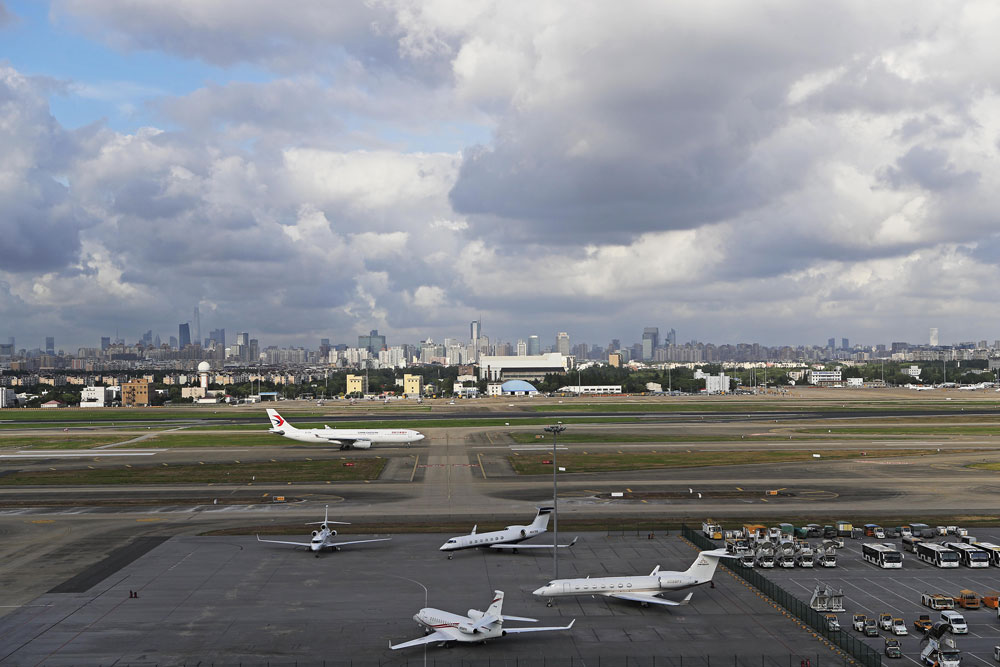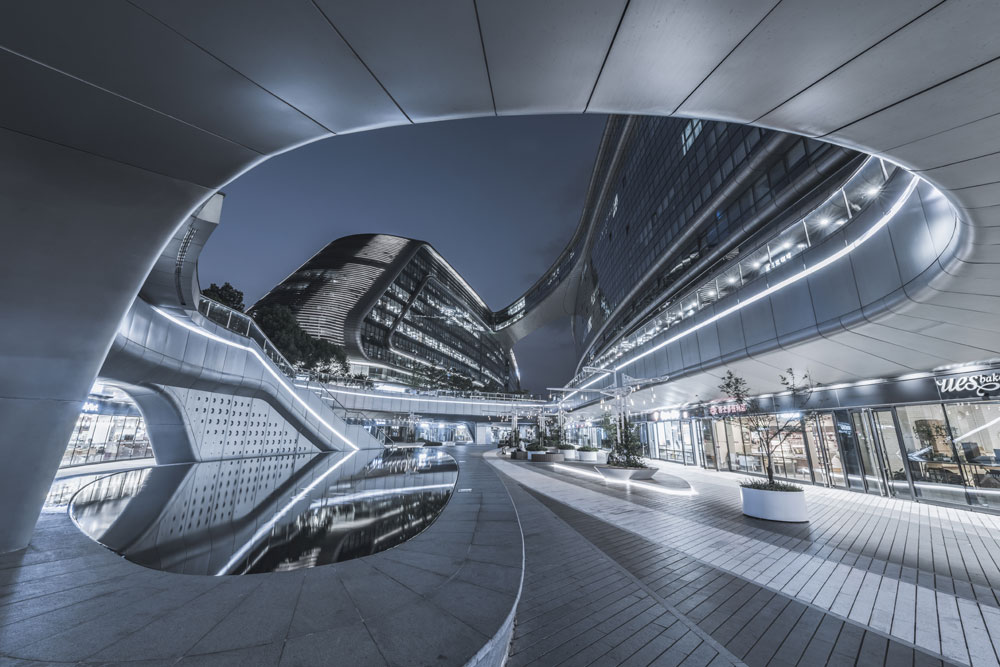Hongqiao builds bridges to the future
A national plan has been drawn up to expand the hub and, more important, the role of the Hongqiao area in the next decade.
A train arrives at or departs daily from Shanghai Hongqiao Railway Station about every 90 seconds as more than 300,000 passengers travel between the city and other areas of China.

Shanghai Hongqiao International Airport is one of the busiest transportation hubs in the country. YIN LIQIN/CHINA NEWS SERVICE
Next door to the station, a plane takes off or lands during this time at Shanghai Hongqiao International Airport, which caters to about 100,000 domestic and international passengers each day.
The airport and station are located in the Hongqiao Comprehensive Transport Hub, which covers 26 square kilometers in the west of the city and also boasts two metro lines and several long-distance bus terminals.
A national plan has been drawn up to expand the hub and, more importantly, the role of the Hongqiao area in the next decade. Spread over 7,000 square kilometers, the area will become a global central business district, international trade center and major transportation hub by 2035.
The overall plan to build the Hongqiao International Hub for Opening-up, submitted by the National Development and Reform Commission, was approved by the State Council in February.
Officials and experts see the plan as an important blueprint for enhancing the country's "dual-circulation" development paradigm, which has domestic circulation as the mainstay and domestic and international circulation reinforcing each other.
Li Qiang, Party chief of Shanghai, said, "The city will work with Jiangsu, Zhejiang and Anhui provinces to build 'Big Hongqiao' into a driver for the regional economy and a bridge between domestic and international markets.
"We will raise the level of openness and functions for the area to strengthen Yangtze River Delta integration," he said on March 2 during a meeting with officials from other parts of the delta on implementing the national plan.
In Chinese, Hongqiao translates as "rainbow bridge", and the term can be applied to many places in Shanghai, as the Hongqiao area has expanded in recent decades.
In 1986, Shanghai established the Hongqiao Economic and Technological Development Zone in the west of the city. Occupying just 0.65 sq km, it was the smallest of the 14 national development zones approved by the State Council.
The area's convenient transportation services for the public and freight were boosted in 2009 with completion of the Hongqiao Comprehensive Transport Hub. This led to further development nearby, with an area occupying 86 sq km designated as the Hongqiao Central Business District in the same year.
In the following decade, office buildings, shopping malls, hotels and exhibition centers were built in the CBD, including the National Exhibition and Convention Center (Shanghai).

A high-speed train arrives at Shanghai Hongqiao Railway Station. GAO ERQIAO/CHINA DAILY
Completed in 2014, the center, which is shaped like a four-leaf clover, became the world's largest single-building exhibition center and home to numerous influential events, including the China International Import Expo. The area was now not only a transportation hub, but a business, exhibitions and conventions venue.
Chen Yin, vice-mayor of Shanghai, said, "The Hongqiao Economic and Technological Development Zone, established in the 1980s, was 'the Hongqiao for Changning district', and the Hongqiao Central Business District was 'the Hongqiao for Shanghai'."
According to the new plan, the Hongqiao International Hub will include the Hongqiao Central Business District and two extended strips-one running north to Suzhou Industrial Park, Jiangsu, and the other running south to Haining, Zhejiang.
"The plan has become an important vehicle for carrying out the national strategy of Yangtze River delta integration-it's 'the Hongqiao for the Delta'," Chen said.
Cities supported
Tang Lizhu, chief industrial analyst at the Shanghai ZhongChuang Institute for Industry & Innovation, said export-oriented industries have been developed in the extended hub area since the 1990s, and the area's combined GDP amounts to 2.3 trillion yuan ($350 billion), nearly 10 percent of the delta's total.
The plan includes government support for the area cities of Jiading, Kunshan and Taicang to further develop industrial chains for automobiles, smart manufacturing and new materials. Construction of an international innovation park for internet technology will be pushed forward in Jiaxing, Zhejiang, and pilot zones will be considered in Suzhou, Jiangsu, for internet of vehicles and blockchain technologies.

Office buildings, shopping malls and hotels have been built in the airport area. CHINA DAILY
Tang said, "With the new plan being implemented, cities in the hub area will have more opportunities to attract good projects and further integrate their economic development with Shanghai and the world."
Earmarked for completion in 2035, the hub will become the crossroads for global flows of freight, business, people and capital, according to the blueprint.
To achieve this goal, the plan includes many construction projects for regional railway networks and also outlines a series of favorable policies for regional integration, foreign entrepreneurship, and international trade and finance.
Multinationals are being encouraged to set up global or regional capital management centers in the hub.
Such centers, which are usually based in corporate headquarters, are mainly responsible for managing multinational companies' cash, operating capital, investment, financing, risks and relations with financial institutions.
"However, some multinational companies with extensive global networks set up regional capital management centers to cover the world's major time zones," said Jin Penghui, vice-president of the Shanghai head office of the People's Bank of China.
He said a cluster of capital management centers is conducive to developing the finance industry, economic growth for the areas in which the centers are located, and will provide the impetus for Shanghai to grow into a world financial center.
Another highlight of the plan is piloting real estate investment trusts for infrastructure projects in the hub area.
To better link Hongqiao and neighboring areas of the Yangtze River Delta region, a large number of infrastructure projects are underway. These include the Shanghai-Suzhou-Huzhou and Shanghai-Jiaxing-Hangzhou high-speed railways, along with extended metro lines better connecting Hongqiao and other areas of Shanghai.

A view of Hongqiao Central Business District. FANG ZHE/XINHUA
Real estate investment trusts are being introduced to finance infrastructure projects, according to the plan, which is also aimed at attracting high-caliber workers and foreign talent to work and live in the area.
Visas and permanent residence policies will be drawn up for qualified foreign talent, schools will be built for foreigners' children, rules laid down for overseas healthcare professionals practicing in clinics, and approval given for foreign companies to open cultural venues such as theaters, cinemas and concert halls.
Yao Kai, professor of business management at Fudan University, said Shanghai, the Chinese city with the most foreigners, has tested many of the policies to make overseas arrivals feel at home.
"Introducing these policies to the Hongqiao International Hub will make the Yangtze River Delta a magnet for global talent," he added.
The plan states that the authorities will promote the exhibition and convention industry in the region, make full use of the China International Import Expo as a global resource allocation and goods distribution platform, and support companies in the area to open free trade accounts with cross-border finance services.
Chen Weili, deputy director of Hongqiao Central Business District, said it is home to more than 70,000 companies, where 380 of them have established their global or regional headquarters.
"We aim to attract 3,000 companies to settle in the core area of the district and we will build more bonded warehouses and exhibition centers to further enhance the spillover effect of the China International Import Expo," Chen said.
Policies tested
Many experts equate the Hongqiao International Hub with two other major national strategic zones involving Shanghai-the demonstration zone for integration of the Yangtze River Delta and the Lingang Special Area of the China (Shanghai) Pilot Free Trade Zone. They feel that Hongqiao acts as a bridge between the two.
Both zones-tasks set for Shanghai by President Xi Jinping-were established in 2019.
Gao Ping, deputy director of the Shanghai ZhongChuang Institute for Industry & Innovation, said, "The Lingang area is playing the trade liberalization card, the Yangtze River Delta is playing the regional cooperation card, and the Hongqiao area is focusing on connection."
He said the plan for the Hongqiao International Hub includes policies first tested in the Yangtze River Delta integration demonstration zone and the Lingang special area, such as allowing eligible companies in the Hongqiao Central Business District to open free trade accounts.
"I think the Hongqiao hub will employ more opening-up policies from Lingang and more policies from the Yangtze River Delta demonstration zone that break provincial barriers," Gao added.

A bird's-eye view of the National Exhibition and Convention Center (Shanghai), which is shaped like a four-leaf clover. WU KAI/XINHUA
Xu Jian, vice-dean of the China Institute for Urban Governance of Shanghai Jiao Tong University, said, "When people talk about opening-up, they usually think of Pudong New Area, because it has attracted a lot of foreign investment and talent, but this was more of a one-way flow.
"With its proximity to neighboring cities in the Yangtze River Delta, the Hongqiao International Hub will further promote Chinese companies going global. It will be a connector for domestic and international trade."
Zhang Wei, deputy head of the Chinese Academy of International Trade and Economic Cooperation, said the measures planned for the Hongqiao area are aimed at bridging the domestic and overseas markets, better facilitating China's industrial and consumption upgrading, producing an optimized road map for industry, and perfecting the country's opening-up.
"The Shanghai Free Trade Zone has opened the gate connecting China's rules and international rules. The Hongqiao area will nurture a regional coordination mechanism amid domestic circulation, and both are important contributions to China's economic growth," she said.

